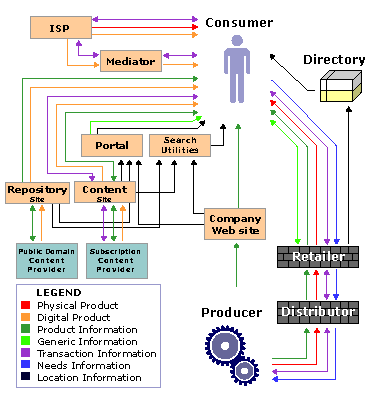| Lesson 7 | Interact stage |
| Objective | Describe the interact model flow stage. |
Interact Model Flow Stage
Once information became readily available, efforts began to group and categorize it, to provide a focal point for users of similar interests.
These users not only wished to absorb information but to discuss and share it with others, including the producers of the information.
Traditionally, the information flow was unidirectional; it was very difficult for the producer to truly get information back from the consumer. There remained a reliance on proxies (i.e., market shares, marketing reports). However, this could leave you vulnerable. Competitors attacked because you were the only product in the space. Now consumers send information about products back to the producers, provide feedback, etc. This bi-directional flow of information was, and still is, extremely valuable to producers.
Traditionally, the information flow was unidirectional; it was very difficult for the producer to truly get information back from the consumer. There remained a reliance on proxies (i.e., market shares, marketing reports). However, this could leave you vulnerable. Competitors attacked because you were the only product in the space. Now consumers send information about products back to the producers, provide feedback, etc. This bi-directional flow of information was, and still is, extremely valuable to producers.

Communities
Once the precedent of bi-directional flow was established, further interaction developed in the next stage.
The most significant development of the interact stage of the Internet evolution is the emergence of communities.
Communities formed around common interests, and required two factors in order to develop:
-
Availability of content:There had to be enough content on the Web so that people with a common interest could have something meaningful around which to gather.
Example: Major providers of subscription-based information such as magazines recognized that they could digitize their product and immediately take advantage of the Web's ability to move digital content. Subscription content providers created content sites to deliver their digital product to the consumer, and the consumer transacted and purchased the information over the Web. - Organization of content: Large numbers of domain content providers built a large repository of content (e.g., libraries, the Smithsonian). Large amounts of public information were digested and made available on the Web.
ecommerce portal | Web based application
Portals
Now, between company sites that provided product information, content sites that provided subscription content, and repository sites that provided public domain information, we had the critical mass of gross information that could facilitate aggregation of the information around communities. What was missing was the "maypole," and that is the role that the portal provided. The portal is the community center. For example, Yahoo.com moved beyond simply being a search engine utility. What began as a portal for people looking for information on the Web, ultimately became more specialized to include community access points, such as financial portals (anything related to financial services, mortgages, insurance, and loans).
Mediators
Lastly, in the Interact stage, we saw the emergence of the role of mediator who acts as middleman between consumers and providers of digital content.
For example, WebTV wanted to create a community and access around the convergence of TV and the Internet. WebTV did not want to have to negotiate infrastructure contacts with ATT and MCI and other infrastructure providers. They did not want to have the expense or ongoing operational considerations for a farm of Web servers and disk farms for content hosting. But they did want to brand Internet access with their name so they negotiated a deal with Microsoft Network, where MS Network would be the ISP. As far as the consumer was concerned, the consumer was purchasing the digital product of access, from the mediator (WebTV) and WebTV was the provider of the digital product.